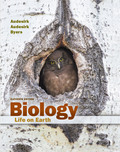
EBK BIOLOGY
11th Edition
ISBN: 8220101472069
Author: Byers
Publisher: PEARSON
expand_more
expand_more
format_list_bulleted
Question
Chapter 29, Problem 5FTB
Summary Introduction
To review:
The given blank space in the statement, “photosynthetic organisms make up the first trophic level. Organisms in higher trophic levels are collectively called ____________ or ___________. Photosynthetic organisms are consumed by organism collectively called __________ or ____________. Animals that feed on other animals are called ________ or_______. Organisms that feed on wastes and dead bodies are called _______ and ______.”
Introduction:
In an ecosystem, feeding habits of the prey and predators are studied as per their trophic level. Each community occupies a specific trophic level. In almost all the ecosystems, the photosynthetic organisms occupy the first trophic level, except in the detritus food chain.
Expert Solution & Answer
Want to see the full answer?
Check out a sample textbook solution
Students have asked these similar questions
Please draw in the missing answer, thank you
Please fill in all blank questions, Thank you
please fill in missing parts , thank you
Chapter 29 Solutions
EBK BIOLOGY
Ch. 29 -
1. Which trophic level(s) must be present to...Ch. 29 - Prob. 2MCCh. 29 - Denitrifying bacteria convert ammonia to nitrate...Ch. 29 -
4. Net primary production per unit area is likely...Ch. 29 - The effect of CO2 emissions from burning fossil...Ch. 29 -
1. Nearly all life gets its energy from _______...Ch. 29 -
2. Photosynthetic organisms are called either...Ch. 29 -
3. Feeding levels within ecosystems are also...Ch. 29 - In general, only about ______ percent of the...Ch. 29 - Prob. 5FTB
Ch. 29 -
6. During the nitrogen cycle, nitrogen gas is...Ch. 29 - Prob. 7FTBCh. 29 - Prob. 1RQCh. 29 -
2. What is a producer? What trophic level does it...Ch. 29 - 3. Define net primary production. Would you...Ch. 29 - Name the first three trophic levels. Among the...Ch. 29 - How do food chains and food webs differ? Which is...Ch. 29 - Define detritivore and decomposer and explain...Ch. 29 -
7. Trace the movement of carbon from one of its...Ch. 29 - Prob. 8RQCh. 29 - Trace a pathway of a phosphorus molecule from a...Ch. 29 -
1. Humans are omnivores who can feed on several...Ch. 29 - Discuss the contribution of human population...
Knowledge Booster
Learn more about
Need a deep-dive on the concept behind this application? Look no further. Learn more about this topic, biology and related others by exploring similar questions and additional content below.Similar questions
- please draw in the answers, thank youarrow_forwarda. On this first grid, assume that the DNA and RNA templates are read left to right. DNA DNA mRNA codon tRNA anticodon polypeptide _strand strand C с A T G A U G C A TRP b. Now do this AGAIN assuming that the DNA and RNA templates are read right to left. DNA DNA strand strand C mRNA codon tRNA anticodon polypeptide 0 A T G A U G с A TRParrow_forwardplease answer all question below with the following answer choice, thank you!arrow_forward
- please draw in the answeres, thank youarrow_forwardA) What is being shown here?B) What is indicated by the RED arrow?C) What is indicated by the BLUE arrow?arrow_forwardPlease identify the curve shown below. What does this curve represent? Please identify A, B, C, D, and E (the orange oval). What is occurring in these regions?arrow_forward
- Please identify the test shown here. 1) What is the test? 2) What does the test indicate? How is it performed? What is CX? 3) Why might the test be performed in a clinical setting? GEN CZ CX CPZ PTZ CACarrow_forwardDetermine how much ATP would a cell produce when using fermentation of a 50 mM glucose solution?arrow_forwardDetermine how much ATP would a cell produce when using aerobic respiration of a 7 mM glucose solution?arrow_forward
- Determine how much ATP would a cell produce when using aerobic respiration to degrade one small protein molecule into 12 molecules of malic acid, how many ATP would that cell make? Malic acid is an intermediate in the Krebs cycle. Assume there is no other carbon source and no acetyl-CoA.arrow_forwardIdentify each of the major endocrine glandsarrow_forwardCome up with a few questions and answers for umbrella species, keystone species, redunant species, and aquatic keystone speciesarrow_forward
arrow_back_ios
SEE MORE QUESTIONS
arrow_forward_ios
Recommended textbooks for you

 Human Biology (MindTap Course List)BiologyISBN:9781305112100Author:Cecie Starr, Beverly McMillanPublisher:Cengage Learning
Human Biology (MindTap Course List)BiologyISBN:9781305112100Author:Cecie Starr, Beverly McMillanPublisher:Cengage Learning Concepts of BiologyBiologyISBN:9781938168116Author:Samantha Fowler, Rebecca Roush, James WisePublisher:OpenStax College
Concepts of BiologyBiologyISBN:9781938168116Author:Samantha Fowler, Rebecca Roush, James WisePublisher:OpenStax College Biology: The Dynamic Science (MindTap Course List)BiologyISBN:9781305389892Author:Peter J. Russell, Paul E. Hertz, Beverly McMillanPublisher:Cengage Learning
Biology: The Dynamic Science (MindTap Course List)BiologyISBN:9781305389892Author:Peter J. Russell, Paul E. Hertz, Beverly McMillanPublisher:Cengage Learning Biology (MindTap Course List)BiologyISBN:9781337392938Author:Eldra Solomon, Charles Martin, Diana W. Martin, Linda R. BergPublisher:Cengage Learning
Biology (MindTap Course List)BiologyISBN:9781337392938Author:Eldra Solomon, Charles Martin, Diana W. Martin, Linda R. BergPublisher:Cengage Learning


Human Biology (MindTap Course List)
Biology
ISBN:9781305112100
Author:Cecie Starr, Beverly McMillan
Publisher:Cengage Learning

Concepts of Biology
Biology
ISBN:9781938168116
Author:Samantha Fowler, Rebecca Roush, James Wise
Publisher:OpenStax College

Biology: The Dynamic Science (MindTap Course List)
Biology
ISBN:9781305389892
Author:Peter J. Russell, Paul E. Hertz, Beverly McMillan
Publisher:Cengage Learning


Biology (MindTap Course List)
Biology
ISBN:9781337392938
Author:Eldra Solomon, Charles Martin, Diana W. Martin, Linda R. Berg
Publisher:Cengage Learning
5 Human Impacts on the Environment: Crash Course Ecology #10; Author: CrashCourse;https://www.youtube.com/watch?v=5eTCZ9L834s;License: Standard YouTube License, CC-BY
Aquatic Ecosystems; Author: Ocean Research & Conservation Association (ORCA);https://www.youtube.com/watch?v=4tU08jCvwGg;License: Standard YouTube License, CC-BY
Aquatic Ecosystems; Author: David Akerman;https://www.youtube.com/watch?v=9T6Q2I_kPeo;License: Standard Youtube License